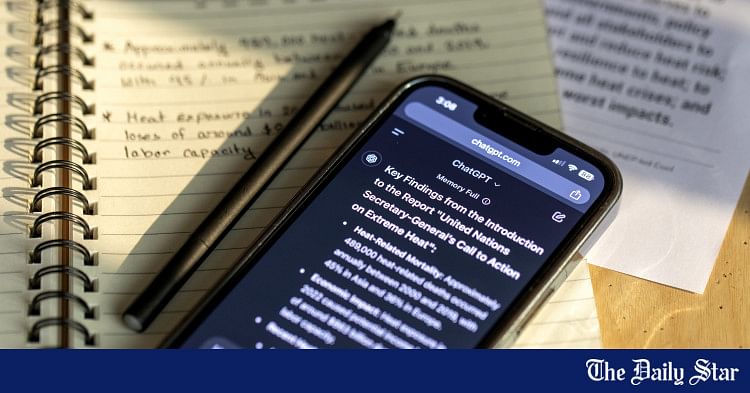Saif
Senior Member
- Joined
- Jan 24, 2024
- Messages
- 15,898
- Likes
- 7,990
- Nation

- Axis Group


Can AI help mitigate long-pending legal cases?
Bangladesh’s legal system is overwhelmed by a staggering backlog of cases, leaving many people waiting for justice for years, sometimes even decades.
Can AI help mitigate long-pending legal cases?

Bangladesh's legal system is overwhelmed by a staggering backlog of cases, leaving many people waiting for justice for years, sometimes even decades. The legal process has become slow and frustrating with nearly 49 lakh cases pending and a severe shortage of judges, according to a newspaper report. Public trust in the judiciary has eroded, and finding solutions to this crisis has become critical. About 70 percent of the cases are backlogged at the witness hearing stage for at least three or more years, whereas 22 percent are backlogged at the investigation stage for one year and above, media reports say. One potential answer lies in using Artificial Intelligence (AI), which could offer much-needed efficiency and innovation to tackle these challenges.
SCALE OF THE PROBLEM
With only one judge for every 95 thousand citizens, Bangladesh's courts are stretched to the limit. As a result, cases drag on for years. This inefficiency is not just inconvenient, it is a denial of timely justice, which affects individuals, families and businesses alike.
HOW AI CAN HELP
Automating document creation and management: AI can help lawyers draft legal documents quickly and accurately. By generating first drafts of contracts or legal papers using templates, AI tools can save lawyers valuable time. Instead of being bogged down in repetitive tasks, legal professionals can focus on more complex issues, helping to move cases forward faster.
Enhancing legal research: Legal research is time-consuming, but AI can change that. AI-powered tools can skim through enormous amounts of data, case laws and statutes, providing quick access to relevant information.
Task management and scheduling: AI can take over the mundane yet critical task of managing lawyers' and judges' schedules. It can remind them of deadlines, upcoming court dates, and pending tasks.
Training junior lawyers: AI can act as a virtual mentor for junior lawyers, helping them learn faster. AI tools can simulate courtroom scenarios, provide real-time feedback on legal drafts and even conduct mock trials.
LOCAL SOLUTIONS FOR LOCAL PROBLEMS
Bangladesh has the potential to create AI solutions tailored to the specific needs of its legal system. Local tech companies are in a unique position to design tools that understand the context of Bangladeshi law. By investing in these technologies, Bangladesh can develop affordable solutions that will help clear the case backlog. Collaboration between the legal community, tech companies, and institutions like the Supreme Court and Bangladesh Bar Council is crucial for success.
Oleyn, a Bangladeshi-Singaporean tech company, is already developing AI-driven solutions through its product "superattorney.ai". Salman Sayeed, co-founder and CEO of Oleyn, said their innovative platform transforms legal services by scaling up operations at a low cost, addressing the high demand for legal assistance while keeping expenses low for clients and increasing revenue for lawyers.
VOICES FROM THE LEGAL INDUSTRY
Lawyer Raiyan Amin points out that "AI can help automate repetitive tasks such as case management, legal research and data entry," but adds that "AI should just assist and mustn't replace human judgment." Barrister Rafaelur Rahman Mehedi agrees, saying, "AI can help with drafting, legal databases and recording court statements, but trust and confidentiality are crucial in law, and we must be careful with AI's role in this."
CONCLUSION
AI has the potential to bring long-overdue changes to Bangladesh's legal system. By streamlining routine tasks, improving research and supporting lawyers, AI can help clear the backlog of cases and speed up justice. As local companies like Oleyn step up to provide innovative solutions, Bangladesh's legal landscape could soon see a much-needed transformation, ensuring that justice is delivered on time.
The author is the chief of staff of a leading startup and a former president of Junior Chamber International (JCI) Bangladesh
Bangladesh's legal system is overwhelmed by a staggering backlog of cases, leaving many people waiting for justice for years, sometimes even decades. The legal process has become slow and frustrating with nearly 49 lakh cases pending and a severe shortage of judges, according to a newspaper report. Public trust in the judiciary has eroded, and finding solutions to this crisis has become critical. About 70 percent of the cases are backlogged at the witness hearing stage for at least three or more years, whereas 22 percent are backlogged at the investigation stage for one year and above, media reports say. One potential answer lies in using Artificial Intelligence (AI), which could offer much-needed efficiency and innovation to tackle these challenges.
SCALE OF THE PROBLEM
With only one judge for every 95 thousand citizens, Bangladesh's courts are stretched to the limit. As a result, cases drag on for years. This inefficiency is not just inconvenient, it is a denial of timely justice, which affects individuals, families and businesses alike.
HOW AI CAN HELP
Automating document creation and management: AI can help lawyers draft legal documents quickly and accurately. By generating first drafts of contracts or legal papers using templates, AI tools can save lawyers valuable time. Instead of being bogged down in repetitive tasks, legal professionals can focus on more complex issues, helping to move cases forward faster.
Enhancing legal research: Legal research is time-consuming, but AI can change that. AI-powered tools can skim through enormous amounts of data, case laws and statutes, providing quick access to relevant information.
Task management and scheduling: AI can take over the mundane yet critical task of managing lawyers' and judges' schedules. It can remind them of deadlines, upcoming court dates, and pending tasks.
Training junior lawyers: AI can act as a virtual mentor for junior lawyers, helping them learn faster. AI tools can simulate courtroom scenarios, provide real-time feedback on legal drafts and even conduct mock trials.
LOCAL SOLUTIONS FOR LOCAL PROBLEMS
Bangladesh has the potential to create AI solutions tailored to the specific needs of its legal system. Local tech companies are in a unique position to design tools that understand the context of Bangladeshi law. By investing in these technologies, Bangladesh can develop affordable solutions that will help clear the case backlog. Collaboration between the legal community, tech companies, and institutions like the Supreme Court and Bangladesh Bar Council is crucial for success.
Oleyn, a Bangladeshi-Singaporean tech company, is already developing AI-driven solutions through its product "superattorney.ai". Salman Sayeed, co-founder and CEO of Oleyn, said their innovative platform transforms legal services by scaling up operations at a low cost, addressing the high demand for legal assistance while keeping expenses low for clients and increasing revenue for lawyers.
VOICES FROM THE LEGAL INDUSTRY
Lawyer Raiyan Amin points out that "AI can help automate repetitive tasks such as case management, legal research and data entry," but adds that "AI should just assist and mustn't replace human judgment." Barrister Rafaelur Rahman Mehedi agrees, saying, "AI can help with drafting, legal databases and recording court statements, but trust and confidentiality are crucial in law, and we must be careful with AI's role in this."
CONCLUSION
AI has the potential to bring long-overdue changes to Bangladesh's legal system. By streamlining routine tasks, improving research and supporting lawyers, AI can help clear the backlog of cases and speed up justice. As local companies like Oleyn step up to provide innovative solutions, Bangladesh's legal landscape could soon see a much-needed transformation, ensuring that justice is delivered on time.
The author is the chief of staff of a leading startup and a former president of Junior Chamber International (JCI) Bangladesh











































